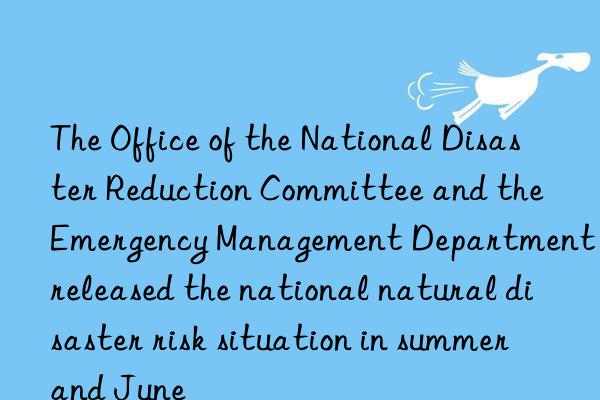
Recently, the Office of the National Disaster Reduction Committee, the Ministry of Emergency Management, the Ministry of Natural Resources, the Ministry of Water Resources, the Ministry of Agriculture and Rural Affairs, the Meteorological Bureau, the Forestry and Grass Bureau and other departments held a conference to discuss the national natural disaster risk situation in summer and June. Business research and judgment. The details are as follows:
1. National natural disaster risk situation in summer
According to a comprehensive analysis, this summer (June-August) in the northern region, floods and hail disasters may occur more heavily; the impact of typhoons may be more severe; there may be periodic droughts in the middle reaches of the Yangtze River; geological disasters may occur frequently in the south and northwest regions; Forest fire risks exist in parts of the Northeast and Southwest.
The first is the risk of floods, wind and hail disasters. The main rainy areas are located in Northeast China, North China, South East China, South Central China, South China, and Southwest China. Strong convective weather is more frequent, and the risk of floods and hail disasters is higher. Larger floods may occur in the Liao River Basin, Nenjiang, Songhua River, Heilongjiang, and the Pearl River Basin, Beijiang, Dongjiang, and Hanjiang Rivers. Regional heavy rain floods may occur in the Liaohe River, Songhua River, and rivers in Zhejiang, Fujian, Hainan, and Yunnan provinces.
The second is the risk of typhoon disasters. The number of typhoons formed in the Northwest Pacific and the South China Sea was 10-13, and the number of landfall was 4-6, which was more than normal. The path of typhoon activity is mainly westbound and northwestward, which will affect the eastern coast of South my country and parts of East China, resulting in 2-4 disastrous typhoon storm surge processes and 8-10 disastrous wave processes. The typhoon landed in my country for the first time earlier than normal (June 29).
The third is the risk of high temperature and drought. The temperature in most parts of the country is close to the same period of the year to high, and the number of high-temperature days is relatively high. Periodic high-temperature heat waves may occur in East China, Central China, and Xinjiang; precipitation in most of Hubei, northern Hunan, northern Chongqing, and northeastern Sichuan is relatively low2 -50%, the risk of periodic summer drought is higher.
The fourth is the risk of geological disasters. Summer has entered a period of concentrated and high incidence of geological disasters. The risk of geological disasters in some areas such as the south and northwest is high. Focus on southern Zhejiang, western Fujian, southeastern Jiangxi, western Hubei, central and southern Hunan, northeastern and central southern Sichuan, northern Chongqing, and Yunnan. Local areas such as the west and north, southern Shaanxi, and southern Gansu.
The fifth is the risk of forest fires. Thunderstorms are gradually increasing in the Greater Khingan Mountains in Northeast China and the Altay region in Xinjiang, and the risk of lightning strikes and fires is relatively high. Some areas such as Hunan, Chongqing, and Sichuan have high temperature and little rain, and there may be periods of high fire danger.
2. National natural disaster risk situation in June
According to a comprehensive analysis, in June, South China will gradually enter the dragon boat water concentration period, the south of the Yangtze River will gradually enter the rainy season, and many parts of the country will enter the main flood season. Super-alarm floods may occur in some rivers; a typhoon may land in the southeastern coastal areas; the risk of geological disasters in the central and southwestern regions is high; the forest fire danger level in the northeast and southwest regions is high; the risk of high temperature and drought in parts of southwest and eastern China higher.
The first is the risk of floods, wind and hail disasters. Parts of Northeast China, South China, and Southwest China have 20-50% more precipitation, and strong convective weather such as periodic heavy precipitation, hail, thunderstorms and strong winds frequently occurs. Some rivers such as the Songhua River in the Songliao River Basin may experience super-warning floods, and snowmelt floods may occur in western and southeastern Tibet and northern Xinjiang.
The second is the risk of typhoon disasters. It is estimated that in June, 1-2 typhoons will form in the northwest Pacific Ocean and the South China Sea, which is close to the same period of the year; among them, 1 typhoon will land or significantly affect the southeastern coastal areas of my country. Affected by factors such as typhoons, there may be one disastrous typhoon storm surge process and one or two disastrous wave processes in my country's sea areas.
The third is the risk of geological disasters. The risk of geological disasters is relatively high in parts of East China, Central South, Southwest, and Northwest China. Among them, the risk of geological disasters is high in some areas such as western Fujian, southeastern Jiangxi, southern Hunan, northeastern Guangxi, southwestern Sichuan, and northwestern Yunnan.
Fourth, forest fire risk. Some areas in eastern Inner Mongolia, northwestern Heilongjiang, southwestern Sichuan, northern Yunnan, and northern Xinjiang have relatively high levels of forest fire danger. Among them, some areas in northeastern Inner Mongolia, northwestern Heilongjiang, southwestern Sichuan, and northern Yunnan have high levels of forest fire danger .
Five is the risk of high temperature and drought. It is expected that in June, the number of high-temperature (≥35°C) days in southern North China, East China, and Central China will be close to the same period of normal years to more than normal, and there may be periodic high-temperature heat waves, which may have adverse effects on outdoor activities, power supply guarantees, and forest fire prevention. The temperature in the eastern part of Southwest China and the northeastern part of North China is relatively high, and the precipitation is relatively low. The drought in some dry areas such as Yunnan may continue.



 微信扫一扫打赏
微信扫一扫打赏
